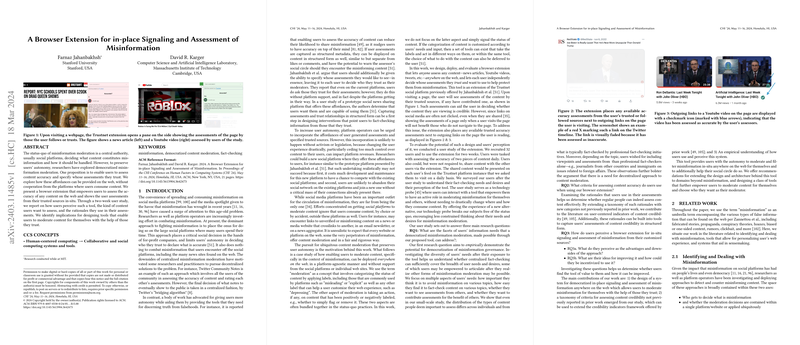Democratizing Misinformation Moderation: A Case Study of a Browser Extension for In-Place Content Assessment
Introduction
The proliferation of misinformation on the web has spurred significant efforts towards identifying and mitigating its spread. Traditional strategies predominantly center around centralized moderation by platform operators or third-party fact-checkers, raising concerns regarding autonomy, bias, and the breadth of content being moderated. In exploring alternative approaches, this paper introduces a browser extension aimed at democratizing the process of content moderation. This platform-agnostic tool empowers users to assess content accuracy across the web and view assessments from their chosen trusted sources directly where the content is consumed.
Design of the Tool
The Trustnet browser extension offers a novel approach by allowing users to both submit and view assessments of content accuracy in-situ. Content can be marked as "accurate," "inaccurate," or flagged for further inquiry directly within the user interface of the extension. The extension's color-coded feedback system—green for accurate, red for inaccurate, and orange for disputed content—provides clear and immediate visual cues regarding content credibility as assessed by the user's trusted network. This user paper confirmed the feasibility of such a tool in expanding the scope of content subject to moderation beyond the limits of centralized fact-checking infrastructure, covering a wide array of sources and types of content, from news articles and social media posts to YouTube videos.
Incentivizing and Trust-Building in Moderation
A central challenge in democratized moderation systems lies in incentivizing user participation and fostering a trusted environment for content assessments. The paper participants underscored the importance of a reputation system and community engagement as significant motivators for contribution. Additionally, users expressed a preference for mechanisms that ensure assessors' credibility, such as displaying political leanings, biases, and relevant credentials. Addressing concerns about abuse and bias requires a comprehensive approach, combining technological solutions with community governance to ensure the integrity of the moderation process.
Democratized Moderation: Challenges and Opportunities
While the browser extension exemplifies the potential of democratized content moderation, several challenges warrant further attention. Users indicated the need for user-specific customization options, suggesting that one-size-fits-all solutions to content labeling and actions might not satisfy diverse user preferences. Another notable consideration is the extension's limitation to desktop usage, excluding a significant portion of web users who primarily access content via mobile devices.
Future Directions
This case paper paves the way for future development in democratized content moderation. Extending beyond accuracy assessments to encompass a broader range of labels, such as content valence or relevance to specific communities, could enhance the tool's utility. Further research is necessary to explore trust dynamics within networks of assessors and the potential for algorithmic prediction models to scale trusted assessments. Additionally, addressing the use case limitations for mobile platforms remains a critical area for future innovation.
Conclusion
The Trustnet browser extension's approach to in-place, democratized content moderation highlights the potential for empowering web users in the fight against misinformation. By enabling users to assess content and rely on assessments from trusted sources directly within their browsing experience, this tool represents a significant step toward a more autonomous, inclusive, and diverse ecosystem for content credibility assessment on the web.
